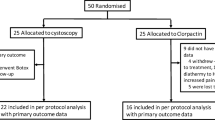Abstract
Purpose
Intravesical instillation of liposomes is a potentially new therapeutic option for subjects with interstitial cystitis/bladder pain syndrome (IC/BPS). The aim of this study was to explore the safety and clinical outcomes of 4 weekly instillations of sphingomyelin liposomes in an open-label cohort of subjects with IC/BPS.
Methods
Fourteen symptomatic IC/BPS subjects were treated with intravesical liposomes once a week for 4 weeks. Safety measurements included laboratory specimen collection, vital signs, post-void residual, and assessment of adverse events (AEs). Efficacy measurements included pain visual analog scales (VAS), voiding diaries, global response assessments (GRAs), and O’Leary-Sant Interstitial Cystitis Symptom and Problem Indices (ICSI and ICPI).
Results
No treatment-related AEs were reported at any time over the course of the study. Urgency VAS scores significantly decreased at 4 weeks (p = 0.0029) and 8 weeks (p = 0.0112) post-treatment. Pain VAS scores significantly decreased at 4 weeks post-treatment (p = 0.0073). Combined ICSI and ICPI scores improved significantly at 4 and 8 weeks (p = 0.002 for both time points) post-treatment. Responses to GRA showed improvement at 4 weeks post-instillation. No significant decrease in urinary frequency was found.
Conclusions
Sphingomyelin liposome instillations were well tolerated in subjects with IC/BPS with no AEs attributed to the test article. Treatment was associated with improvements in pain, urinary urgency, and overall symptom scores. Placebo-controlled clinical trials are needed to assess this potential therapy for IC/BPS.



Similar content being viewed by others
References
Nordling J (2004) Interstitial cystitis: How should we diagnose it and treat it in 2004? Curr Opin Urol 14:323–327
Berry SH, Elliott MN, Suttorp M et al (2011) Prevalence and incidence of bladder pain syndrome/interstitial cystitis among adult females in the United States. J Urol 186:540–544
Clemens JQ, Meenan RT, Rosetti MC et al (2005) Prevalence and incidence of interstitial cystitis in a managed care population. J Urol 173:98–102
Gardella B, Porru D, Ferdeghini F et al (2008) Insight into urogynecologic features of women with interstitial cystitis/painful bladder syndrome. Eur Urol 54:1145–1153
Negrete HO, Lavelle JP, Berg J et al (1996) Permeability properties of the intact mammalian bladder epithelium. Am J Physiol 271:F886–F894
Gregoriadis G (1976) The carrier potential of liposomes in biology and medicine (first of two parts). N Engl J Med 295:704–710
Pavelic Z, Skalko-Basnet N, Jalsenjak I (2005) Characterization and in vitro evaluation of bioadhesive liposome gels for local therapy of vaginitis. Int J Pharm 301:140–148
Tyagi P, Chancellor M, Yoshimura N et al (2008) Activity of different phospholipids in attenuating hyperactivity in bladder irritation. BJU Int 101:627–632
Kaufman J, Tyagi V, Anthony M et al (2010) State of the art in intravesical therapy for lower urinary tract symptoms. Rev Urol 12:e181–e189
Hill WG, Zeidel ML (2000) Reconstituting the barrier properties of a water-tight epithelial membrane by design of leaflet-specific liposomes. J Biol Chem 275:30176–30185
Tyagi P, Hsieh VC, Yoshimura N et al (2009) Instillation of liposomes vs dimethyl sulphoxide or pentosan polysulphate for reducing bladder hyperactivity. BJU Int 104:1689–1692
Chuang YC, Lee WC, Lee WC et al (2009) Intravesical liposome versus oral pentosan polysulfate for interstitial cystitis/painful bladder syndrome. J Urol 182:1393–1400
Peters KM, Hasenau DL, Anthony M et al (2012). Novel therapy with intravesical liposomes for ulcerative interstitial cystitis/painful bladder syndrome. LUTS: Lower Urinary Tract Symptoms 4: 51–53
Acknowledgments
Authors received funding from the National Institutes of Health DK085733.
Conflict of interest
KMP, DH, and KAK declare no conflict of interest. MBC is inventor and chief scientific officer for Lipella Pharmaceuticals, Inc. MA and JK are employed by Lipella Pharmaceuticals, Inc.
Author information
Authors and Affiliations
Corresponding author
Additional information
ClinicalTrial.gov Identifier: NCT01731470.
Rights and permissions
About this article
Cite this article
Peters, K.M., Hasenau, D., Killinger, K.A. et al. Liposomal bladder instillations for IC/BPS: an open-label clinical evaluation. Int Urol Nephrol 46, 2291–2295 (2014). https://doi.org/10.1007/s11255-014-0828-5
Received:
Accepted:
Published:
Issue Date:
DOI: https://doi.org/10.1007/s11255-014-0828-5




